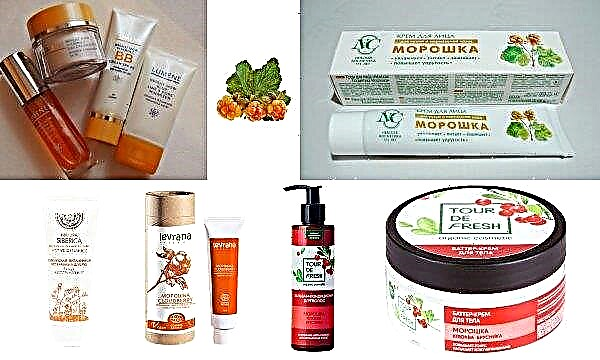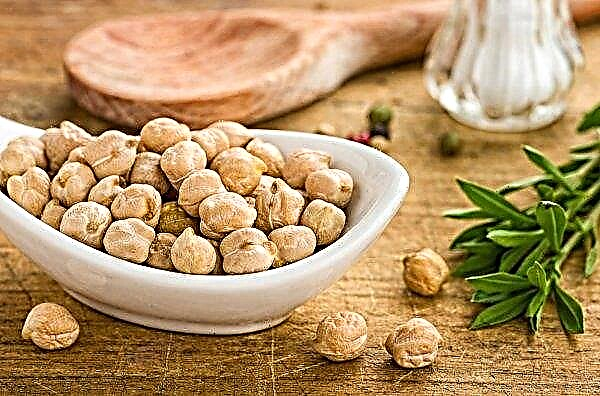Among most gardeners, chickpeas are not considered traditional and promising for cultivation. However, this plant can subdue even the sophisticated gardener with its unpretentiousness and particularly fragrant crop. The article describes in detail how chickpeas Privo 1 differs from other varieties of culture, as well as its detailed characteristics.
Chickpeas: A General Characteristic of Culture
Chickpea is an annual herbaceous plant belonging to the genus of the same name. It belongs to a large family of leguminous crops used to produce high-quality grain products.

Despite the fact that this plant is the brightest representative of the legume family, it has some differences from the more common green peas and green beans.
This culture is aimed at collecting and harvesting fruits for subsequent storage in dried form, which allows you to create highly nutritious cereals, characterized by increased stamina.
The homeland of the plant is considered to be the territory of Central Asia, where it has been a traditional food culture since ancient times. Today, the geography of growing this fruit species has increased significantly. Chickpea beans have become a traditional ingredient in the cuisine of the Mediterranean, India, Africa and Europe.
The main value of chickpea is its harvest, represents chickpeas rounded or elongated beans, ground in a pod. Unripe grains and pods have a rich green hue, but as the grains and pods ripen, the color changes to brownish-yellow.
The plant has a fairly high value for the modern food industry, its fruits are characterized by a high protein content, which reaches 30% of the total mass. This makes it possible to satisfy the daily human need for this substance in just one step.
 Chickpea is considered one of the oldest plants cultivated by man. According to archaeological finds, its beans were actively used in food as early as 5 millennium BC. e.
Chickpea is considered one of the oldest plants cultivated by man. According to archaeological finds, its beans were actively used in food as early as 5 millennium BC. e.
In addition, the culture allows you to get highly nutritious substances with minimal effort and money. Chickpeas, often combined with other legumes, are considered the best plant for restoring poor soil.
Specific nitrogen-fixing bacteria develop in the basal layer of chickpea soil. In symbiosis with the plant, they fix atmospheric nitrogen, saturating the soil with a valuable substance. Thanks to this, Privo 1 is one of the best predecessors, regardless of the type of subsequent culture.
Did you know? Chickpeas do not tend to accumulate harmful substances in beans, which is why the crop of this plant is considered environmentally friendly. This property does not even depend on the region of cultivation, as well as the intensity of agricultural techniques for growing crops.
Nuth Privo 1: selection history
The history of the appearance of this fruit hybrid began at the turn of the 80s and 90s of the twentieth century. During this period, within the walls of the Volgograd Scientific Research Institute of Breeding and Seed Production, scientists set themselves the task of creating a completely new hybrid of highly productive chickpeas, combining all the qualities that are important for successful cultivation.
 For the selection of a new plant, the collection variety Yubileiny was selected, which was later crossed with a selected seedling of Afghan chickpea from the institute's collection.
For the selection of a new plant, the collection variety Yubileiny was selected, which was later crossed with a selected seedling of Afghan chickpea from the institute's collection.
In the course of multi-stage crossing, it was possible to obtain a unique plant that is distinguished by completely new stable characters.
The hybrid fell into state trials in the early 90s of the twentieth century, after which in 1995 the variety Privo 1 received official registration. This plant is recommended for cultivation in all climatic zones of Russia, with the exception of Siberia, as well as in similar territories of other countries.
Botanical Description
This variety may differ in special individual traits. This plant is an annual herbaceous shrub with a well-branched stem. The surface of the shoots is medium density and is covered with dense pubescence; for every 10 cm of the total length of the stem, about 2-3 shoots develop. Each of them is covered with small pinnate leaves located opposite each other. Depending on the growing conditions, the average height of the plant is from 50 to 80 cm.
 1 - general view of the plant in the flowering phase; 2 - apical part of a flowering shoot; 3 - the fetus; 4 - seeds.
1 - general view of the plant in the flowering phase; 2 - apical part of a flowering shoot; 3 - the fetus; 4 - seeds.
The flowers of the plant are small, of all kinds of white shades, they are located on a bush singly. After flowering, ovaries form on the bush, from which small pods gradually grow. Each of them contains 1-2 seeds, but sometimes their number can increase to 3.
Check out

The seed is a failure oval bean, light yellow in diameter with a diameter of about 8-10 mm. On one plant, up to 30 beans can ripen, but under optimal conditions their number can increase up to 80 pcs.
Economic and productive characteristics of the variety:
- the ripening period of the crop is from 70 to 90 days;
- the mass of 100 seeds reaches 230–270 g;
- productivity within 20–30 c / ha;
- high resistance to lodging, drought and shedding of beans;
- the amount of protein in the crop reaches 26% of the total mass;
- the variety is resistant to caryopsis and ascochitosis.
Chemical and vitamin composition
In addition to the high content of various proteins, the plant also boasts other substances that are important for health. The beans contain 18 valuable amino acids, isoflavones and beta carotene.

Of the trace elements concentrated in them are cuprum, magnesium, potassium, phosphorus, zinc, ferum and sodium. The most valuable in composition is a complex of all kinds of vitamins, these include A, E, K, C, group B (B1 – B6, B9).
Nutrition value of chickpea crop per 100 g:
- fats - 6 g;
- proteins - 26 g;
- carbohydrates - 55 g;
- water - 7 g;
- ash - 3 g;
- calorie content - 378 kcal.
Important! The rich composition of beans directly depends on the effectiveness of cultivating crops. Therefore, in order to achieve the best performance, the beds must be provided with the necessary attention and specific care.
Benefit and harm
- The main health benefits of chickpeas are:
- is an ideal dietary product;
- the fruits are instantly absorbed by the body;
- high-quality and inexpensive source of valuable proteins and carbohydrates;
- is the best analogue of meat products (in protein and amino acid composition);
- has good calorie content and nutritional value;
- all kinds of components of the product improve the condition of the body with pathologies of the liver, spleen and intestines, anemia, arrhythmia, lumbar pain;
- normalizes blood sugar levels.
- Beans have plants and some disadvantages, especially:
- with a sharp inclusion of the product in the diet, increased gas formation in the intestine is observed;
- if combined with cold water, bean-based meals can trigger stomach cramps;
- in combination with apples and pears, chickpeas can cause burdening and disruption of the digestive tract;
- uncontrolled use of beans can trigger an exacerbation of allergies, chronic diseases of the genitourinary system, stomach ulcers, thrombophlebitis and gout.
Use prospects
Chickpeas can be called an indispensable product in the daily diet; it is rich in an abundance of all kinds of valuable and useful substances for human health. However, today this culture is considered a novelty for many, therefore, it is often not included in the list of plants promising for cultivation. But, in fact, this type of legumes can be called more than important for modern farming.

The plant harvest has a special aroma and taste, so chickpeas can absolutely successfully diversify the daily diet, as well as improve the taste of almost all famous dishes based on whole bean grains and cereals.
In addition, this plant may be the best alternative to siderate species., since only 1-2 seasons of chickpea cultivation on the site can significantly increase the amount of freely available nitrogen in the soil. And this is one of the main conditions for the fertility of any site.
Important! Before using chickpeas for medicinal purposes, you should always consult with doctors. Otherwise, the product may cause a complication of the course of diseases and the appearance of concomitant pathologies of the underlying ailment.
In recent years, this plant is gaining popularity in medicine. All kinds of extracts and other preparations based on it have found wide application in the treatment of most acute and chronic pathologies known to mankind.
Chickpea has gained particular popularity in cosmetology, bean flour is used to prepare all kinds of cleansing masks that can overcome acne, peeling of the outer skin, greasy skin shine, and also give the skin a natural shade and color.

All of the above suggests that gradually chickpeas become one of the most sought after crops. Already today, its cultivation and export is a tangible share of the budget of many African countries, as well as Thailand.
Check out

Therefore, increasing the area of its sowing every year becomes not only profitable, but also allows you to get tangible economic growth, unlike other crops.
Privo 1 is the brightest representative of highly productive leguminous hybrids of the Nut genus.
This plant is distinguished by excellent production and taste characteristics, therefore, it can successfully compete with almost any cultivar.
Therefore, chickpea crops of this variety today can be called not only expedient, but also an important component of the successful development of any farm.












